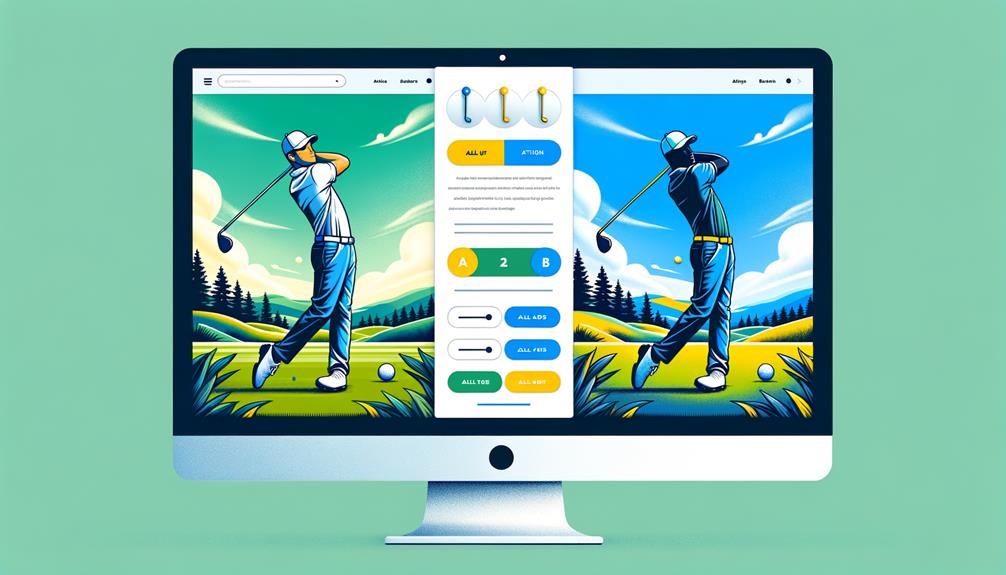Recent data shows that email marketing in the sports industry, including golf, has an average open rate of around 20.41%. You're likely aiming to surpass this benchmark, and to do so, understanding the nuances of A/B testing is essential for refining your email promotions.
By segmenting your audience and testing variant elements of your campaign—whether it's the subject line, the offer itself, or the call to action—you can uncover what truly resonates with your subscribers.
But how do you design an A/B test that yields actionable insights without skewing your data or wasting resources? The key lies in a strategic approach that balances creativity with analytical rigor.
As you contemplate the potential uplift in engagement and conversion rates, consider the untapped opportunities that a well-executed A/B test could reveal for your next golf email campaign.
Key Takeaways
- A/B testing is a data-driven approach that compares two versions of a campaign to determine which performs better.
- Strategic design choices in email aesthetics, such as font styles and color schemes, can resonate with the audience.
- The control group is important as it represents the benchmark for measuring performance variations.
- Analyzing A/B test results provides insights for refining golf email promotions and implementing successful strategies.
Understanding A/B Testing Basics

To optimize your golf email promotions effectively, you must grasp the essentials of A/B testing, a data-driven approach that compares two versions of a campaign to determine which performs better. This technique hinges on creating a control group and a variant. Your control group receives the current version of the email, while the variant group gets the new version with one key change. It could be the subject line, imagery, or call-to-action.
You're not just shooting in the dark; A/B testing is rooted in test significance. By analyzing the results—open rates, click-through rates, conversions—you'll identify which version resonates more with your audience.
But beware, not all differences are meaningful. Test significance tells you if the results are due to the change made or just random variation.
Designing Your Email Variants
Having understood the significance of test results in A/B testing, let's focus on crafting your email variants to ensure each change precisely targets potential improvements in your golf email promotions. You're not just sending out information; you're curating an experience. Look at your email aesthetics; this isn't about mere prettiness, but about strategic design choices that resonate with your audience. Does a sleek, minimalist template convey your brand's sophistication or is a more vibrant, image-rich layout going to clinch higher engagement rates? Each element, from font styles to color schemes, should be chosen with an analytical eye.
Now, let's dive into personalization tactics. It's about liberation from one-size-fits-all marketing. Harness data to tailor your content. Imagine an email that addresses the recipient by name, acknowledges their last purchase, or suggests products based on their browsing history. This isn't a shot in the dark; it's a data-driven arrow aimed straight at your customer's interests.
Setting Up Your Test Parameters

Once your email variants are ready, it's crucial to establish clear, measurable parameters for your A/B test to accurately assess the impact of each element on your golf email promotions. You'll need to understand the control group importance, as this group represents your standard – the benchmark against which you'll measure performance variations. It's vital to ensure that your control group is large enough to be statistically significant, yet similar enough to the test groups to warrant fair comparison.
Variable isolation is the next critical step. You must identify and modify one element at a time – be it the subject line, imagery, or call-to-action. This precision enables you to pinpoint exactly what drives your audience to engage or convert, without the noise of confounding factors.
As you define your parameters, consider the end goals: are you aiming for more open rates, click-through rates, or direct conversions? Your parameters should align with these objectives to facilitate data-driven decisions. Keep your test duration consistent, and make sure that the sample size is adequate to detect meaningful differences.
Analyzing A/B Test Results
After your A/B test concludes, it's crucial you meticulously examine the collected data to discern which variant—the A or B—ultimately drove better performance in your golf email promotions. You're seeking liberation from indecision, and the numbers are your key to unlocking potential.
Dive into the metrics: open rates, click-through rates, conversion rates. These figures aren't just numbers; they're the pulse of your strategy, the rhythm of success.
As you sift through the results, apply test significance principles. You're not just looking at which variant had higher numbers; you're examining if the difference is statistically significant. A difference that's significant is your green light; it means the results aren't due to random chance. Your data's got clout; it's robust, reliable.
Now, embrace result interpretation with a critical eye. Which variant is the champion? Did version A's snappy subject line outperform B's? If the answer points to a clear victor, you've struck gold. But don't stop there. Look for patterns, anomalies, insights that inform future campaigns. You're decoding the DNA of your audience's behavior, crafting emails that resonate, compel, and convert.
Your path to email promotion mastery is data-driven—forge ahead with confidence.
Implementing Successful Strategies

Armed with the insights gleaned from your A/B test analysis, you're now poised to refine your golf email promotions with strategies proven to engage and convert your audience. The data's spoken – it's time to act with precision and finesse.
Let's talk promotion timing. Your A/B test results likely revealed optimal times to send emails when your prospects are most receptive. Perhaps weekend mornings saw higher open rates, or weekday evenings led to better engagement. Use this data to schedule your campaigns strategically, ensuring each email lands at the moment your audience is ready to absorb your content and act on it.
Next, harness the power of audience segmentation. Break down your email list into smaller, behavior-based groups to tailor your messaging. Perhaps you discovered avid golfers react positively to new gear announcements, while occasional players are more price-sensitive and respond to discounts. Segmenting allows you to personalize your approach, giving your audience the freedom to receive content that resonates with their specific golfing lifestyle.
How Can A/B Testing Improve the Effectiveness of Targeted Email Campaigns for Golf Discounts?
A/B testing can significantly improve the effectiveness of your targeted golf discounts email campaign. By testing variations of your email content, subject lines, and call-to-action buttons, you can determine what resonates best with your audience and ultimately increase your email campaign’s success rate.
How Can A/B Testing Improve the Effectiveness of Golf Email Promotions?
A/B testing can significantly enhance the efficacy of email marketing for golf promotions. By testing different variables such as subject lines, call-to-action, and imagery, golf businesses can gain valuable insights into which strategies resonate best with their audience. This optimization can lead to higher engagement and ultimately increased sales.
How Can A/B Testing Help Improve the Effectiveness of Email Sequences for Golf Promotions?
Implementing A/B testing can greatly enhance the effectiveness of email marketing for golf tee promotions. By testing different variations of email sequences, such as subject lines, CTAs, and content, marketers can identify which approach resonates best with their audience, leading to increased engagement and ultimately, more conversions.
Frequently Asked Questions
How Can We Ensure That Our A/B Testing Does Not Alienate or Irritate Our Subscriber Base With Too Many Variations or Frequent Changes?
To avoid testing fatigue and subscriber backlash, you'll want to monitor engagement metrics closely. If you see a dip in open rates or an increase in unsubscribes, it's time to reassess your testing frequency.
Implement targeted variations and only make changes that are driven by clear data insights. This approach ensures you're respecting your audience's preferences and offering them the liberation of content that truly resonates, without overwhelming them.
Can A/B Testing for Email Promotions Be Effectively Integrated With Customer Segmentation Strategies, and if So, How?
You can indeed blend A/B testing with customer segmentation strategies.
By analyzing customer profiles and behavioral triggers, you'll send targeted emails that resonate more effectively.
This method ensures you're not just guessing what works; you're leveraging data to make informed decisions.
It's a strategy that frees you from one-size-fits-all campaigns, allowing for personalization that speaks directly to the user's interests and habits, thus enhancing engagement and conversion rates.
What Legal and Ethical Considerations Should We Be Aware of When Conducting A/B Testing on Golf Email Promotions?
When you're navigating the maze of legalities, remember data privacy is your compass, and consent compliance your North Star.
Always obtain explicit consent before collecting personal information for your tests. Ensure you're abiding by regulations like GDPR or CCPA, which champion consumer rights.
Your approach should be data-driven, targeting only the keenest insights while respecting individual freedom.
It's not just about playing by the rules; it's about empowering your audience.
How Do We Account for External Factors, Such as Weather or Seasonal Trends, That Could Impact the Performance of Our Golf Email Promotions During A/B Testing?
When accounting for external factors like weather or seasonal trends, you'll need to apply weather normalization and seasonal adjustments.
Analyze historical data to identify patterns and adjust your metrics accordingly. This data-driven approach ensures you're targeting your audience effectively, liberating them from misleading results.
Is There a Way to Measure the Long-Term Impact of A/B-Tested Email Promotions on Customer Loyalty and Lifetime Value in the Golf Industry?
You can gauge the lasting effect of email promotions on customer retention and profit margins by tracking repeat purchase rates, engagement metrics, and lifetime value (LTV) over extended periods. By analyzing this data, you'll identify trends indicating loyalty shifts.
It's essential to compare cohorts exposed to different promotional strategies, ensuring you're drawing from a data-driven perspective that aligns with your audience's desire for strategic freedom in their marketing decisions.
Conclusion
Now you've got the tools to drive your golf email campaign straight down the fairway. Remember, A/B testing isn't a one-shot deal—it's an ongoing journey to refine your swing.
Keep analyzing the data, learn from each campaign, and soon you'll be scoring under par with every email you send. Trust the process, and your efforts will tee you up for success.
Stay the course, and watch your engagement rates soar to the green!










